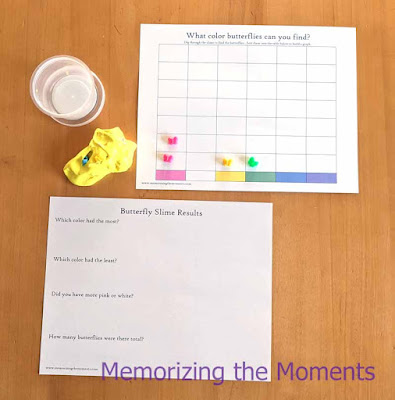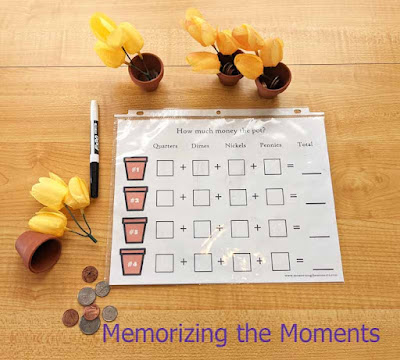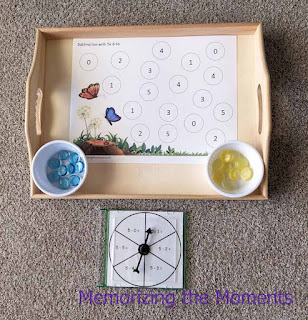I've been having a lot of fun making themed printable math activities the last few months. It's also so much more enjoyable for Archer than just practicing math skills on worksheets. Here are some of the spring activities I made recently.
Monday, April 25, 2022
Spring Math Activities
Tuesday, April 19, 2022
Spring Math Spinner Game
April has me thinking Spring, so I have been working on some spring/bug/garden themed activities. One of the first ones I made was this Spring Butterfly Math Spinner Game. The one we made for St. Patrick's worked well for us and I'll probably continue to make them for various seasons/holidays throughout this year.
I made sheets for both addition (5-9s) and subtraction (5-10s). The subtraction is still kind of a stretch for him, but we can always get out an abacus to help. Also, I wanted this one set of printables to be able to last us a year or two.
Initially, I presented it like this, with just one color of beads for him to complete on his own. I taped one of these spinners to a CD case and then can just switch out the spinner inside (I actually just reused the spinner I made for his St. Patrick's spinner game).
He ended up wanting to play together, so I switched it to this setup. We each had the same number of gems and we took turns spinning and placing gems, trying to see who could run out first.
Print the Spring Math Spinner Games Here
You might like some of my other Spring Resources:
Thursday, April 14, 2022
The Importance Of Exercise For Children
It is no secret that exercise is essential for both children and adults. However, many people don’t realize just how important it actually is. Exercise has many benefits for children, including improved physical health, cognitive function, and emotional well-being. The following blog will discuss the importance of exercise for children and why it should be a part of their daily lives!
1) Improved Physical Health
Engaging in regular physical activity is one of the most important things children can do for their health. Exercise helps to build strong bones and muscles, prevent obesity, and reduce the risk of developing chronic diseases such as heart disease, type II diabetes, and some forms of cancer.
In addition to these long-term benefits, exercise also provides children with immediate improvements in their physical health. For example, exercise has been shown to improve cardiovascular fitness, increase muscle strength and endurance, and help children maintain healthy body weight.
All of these physical benefits are important for children’s overall health and well-being. However, it is worth noting that even moderate amounts of exercise can have a positive impact on children’s health. So read an informative piece on exercise and encourage them to get moving and be as active as they can!
2) Improved Cognitive Function
Exercise has also been shown to improve children’s cognitive function. A recent study found that children who engaged in regular physical activity had better academic performance than those who did not exercise regularly. In addition, exercise has been linked to improved memory, attention, and executive function (i.e., the ability to plan, organize, and complete tasks).
It is believed that the benefits of exercise on cognitive function are due to the fact that exercise increases blood flow to the brain. This increased blood flow delivers more oxygen and nutrients to the brain, which helps to support healthy brain function.
3) Improved Emotional Well-Being
In addition to the physical and cognitive benefits of exercise, children who are active also tend to have better emotional well-being. Exercise has been shown to reduce anxiety and depression, improve self-esteem, and increase feelings of happiness and calmness.
It is believed that the emotional benefits of exercise are due to the fact that exercise releases endorphins, which are hormones that have mood-boosting effects. In addition, exercise can help to distract children from negative thoughts and emotions.
4) A Lifetime Of Benefits
The benefits of exercise are not just limited to childhood. In fact, the habits children develop now will impact their health and well-being for the rest of their lives. Children who are active and exercise regularly are more likely to continue these habits into adulthood. This means that they will be more likely to enjoy the lifelong benefits of exercise, such as a reduced risk of chronic disease and improved cognitive function.
In conclusion, exercise is important for children for a variety of reasons. It can improve their physical health, cognitive function, and emotional well-being. In addition, the benefits of exercise extend beyond childhood and can impact children’s health and well-being for the rest of their lives.
This is a contributed post.
Wednesday, April 13, 2022
How to Boost Your Child's Academic Potential
As a mom, you want to do everything in your power to help your child succeed. One of the best things you can do for your child's academic potential is to start boosting their brain power early! This blog post will discuss some simple ways that you can help prepare your toddler for a successful academic future. Keep reading to learn more!
1) Read to your child every day
The first step to boosting your child's academic potential is to make sure that you are reading to them every day. This exposure to language will help them develop important literacy skills that will be beneficial in school and beyond. Make sure to choose books that are age-appropriate and engaging for your child so that they can get the most out of the experience.
In addition to helping with literacy skills, reading aloud to your child on a daily basis can also promote bonding and communication. This quality time spent together will help build a strong foundation for a healthy parent-child relationship.
2) Help your child with his or her homework
Another way to support your child's academic potential is to help them with their homework when they are old enough to start school. This will not only ensure that they are completing their assignments correctly, but it will also give you the opportunity to bond with your child and help them develop positive study habits.
When helping your child with homework, be sure to take a break if either of you starts to feel frustrated. It is important to maintain a positive attitude towards learning so that your child doesn't begin to associate schoolwork with negative emotions.
3) Encourage your child to explore new interests and learn new things
As your child grows, it is important to encourage their interests and help them explore new things. This will not only make them well-rounded individuals, but it will also help them develop a love for learning.
There are many ways that you can encourage your child to learn new things. For example, you can take them on educational field trips, enroll them in extracurricular activities, or simply have conversations with them about their day and what they have learned. The important thing is that you are fostering a love of learning in your child so that they can reach their full academic potential.
4) Make learning fun!
One of the best ways to boost your child's academic potential is to make learning fun. If your child enjoys the process of learning, they are more likely to be successful in school and beyond.
There are many ways that you can make learning fun for your child. For example, you can sing songs about the alphabet, use resources like Age of Learning, or read bedtime stories that incorporate numbers and counting. The possibilities are endless! Just use your imagination and get creative.
In conclusion, there are many simple things that you can do to help boost your child's academic potential. By reading to them every day, helping them with their homework, and encouraging their interests, you can set them up for a bright future. Just remember to have fun with it!
















































